Little Tern |
Towra is now one of the most significant breeding sites on the Australian east coast. NPWS is working hard to ensure the number of breeding pairs and chicks increases.
(most pictures supplied by Geoff Ross, NPWS) |
|
|
The Little Tern (Sterna albifrons) pictured above is an endangered shorebird which migrates to Botany Bay from Japan every year to breed. You can see the sequence of the life of the Little Tern from brand new hatchling (left), through to chick stage (centre) and to adulthood (right).
Spit Island (below) is managed by National Parks and Wildlife Service as a Little Tern breeding site and as a site for feeding and roosting for migratory waders and other wetlands birds. Other species have also benefited from the Little Tern Management. The island provides a more secure nesting area than mainland sites because of its isolation from foxes and cats |
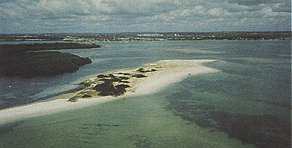 |
| Just prior to the breeding period (October to February) volunteers assist NPWS to clear roosting areas of vegetation for the Little Tern which prefers clear sandy areas to nest. Fox baiting and sandbagging (below) is undertaken to protect the site from predators and storms and tides. |

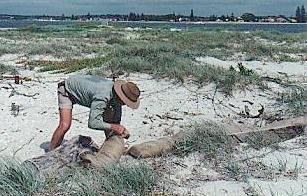 |
| NPWS, via Technical Officer Geoff Ross, and volunteers have been undertaking habitat management, monitoring and research on Little Terns at Spit Island since 1993. |
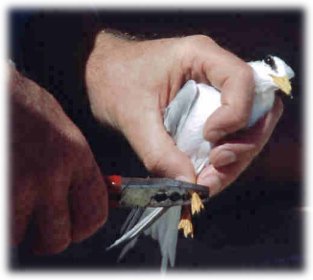 |
| Part of this management involves erecting interpretive signage (below) |
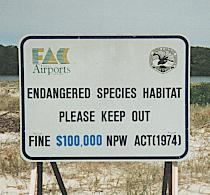 |
A Little Tern colony, displaced from the northern shores of Botany Bay by airport construction, has been successfully relocated to the island.
The table below shows the breeding statistics for the 1998/99 season |
| Number of Nests |
73 |
| Number of Eggs |
163 |
| Number of chicks banded |
121 |
| Number of birds fledged |
43 |
| Number fledged 1997/98 |
34 |
|
| Based on breeding productivity, Towra Point is now the 2nd most significant breeding site for Little Terns on the Australian east coast. The island produces about 13 percent of the state's Little Tern breeding population each year. Each year the number of Little Terns increases and through tagging methods valuable information is gained on their breeding habits. There is evidence that the Little Terns which hatch on the island are coming back to nest and the number of breeding pairs have increased. |
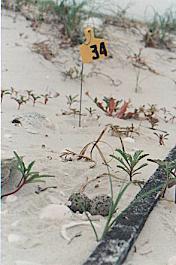 |
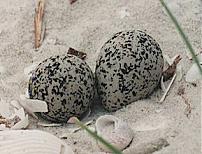 |
| Other bird species have benefitted from Little Tern management. Red-capped plover have nested successfully since 1994. You can see their eggs above and the nest clearly marked with a nest tag. |
|
The Spit Island area is covered under State Environmental Planning Policy No.39 - Spit Island Bird Habitat, which enables development for the purpose of creating and protecting a bird habitat at Spit Island to be carried out without Council consent being required. However, EIS and approval from NPWS, Fisheries and EPA is required.
There is concern that the island may join up to the mainland. The level of sand movement in the Bay is high and it is estimated that 7000 cubic metres of sand is shifted each year in this area, so eventually the island may silt up to the mainland. If this does occur it would be very difficult to maintain protection. One fox could wipe out the whole Little Tern colony in one night.
While the island remains separated from the mainland the population of Little Tern will increase and they will have a safe breeding ground. |
| top of page |



